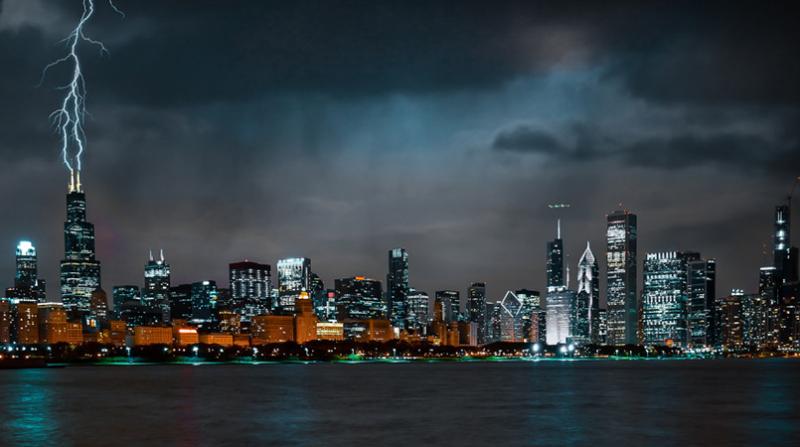Vaisala Xweather celebrates four decades of building the world’s most advanced lightning detection network
Vaisala
Press release
June 1, 2023
40 years of protecting Americans from lightning – Vaisala Xweather celebrates four decades of building the world’s most advanced lightning detection network
Since 1983, increased lightning safety awareness has helped decrease deaths by lightning by almost two thirds in the U.S. The economic impacts of lightning have also decreased, with improved, real-time lightning detection leading to significantly lower downtime for the electrical grid, utilities, and air transport.
Vaisala’s U.S. National Lightning Detection Network (NLDN), the most accurate, reliable, and scientifically validated lightning detection network in the country, turns 40 years old on June 1, 2023. The lightning data provided by the NLDN has had a profound impact on American society. With its highly localized insights, meteorologists have been able to improve their forecasts of dangerous thunderstorms, and energy and infrastructure companies have been able to better protect critical power, utility, and communications systems. The data has also allowed airline pilots to take their passengers safely to the skies.
“Everyone in the United States benefits from the NLDN, either directly or indirectly. Globally, 80% of all national meteorological agencies, including the National Weather Service, that need lightning data, have chosen to use ours to help people stay safe from one of nature’s most violent forces,” says Ryan Said, Senior Scientist at Vaisala Xweather.
Personal safety has naturally been a key part of the development of the detection network. During the time that the NLDN has been operating, lightning-related deaths or injuries have dropped significantly: From 1983 to 1998, there were on average 69 deaths per year from lightning in the United States. For the period 2007 through 2022, that number had declined to 24, a decrease of almost 70 percent.
The societal and economic impact of the NLDN has also been significant. The electrical grid is prone to outages from overvoltage caused by lightning strikes. Aviation is also a strongly affected industry, with safety regulations requiring operations at airports to stop during thunderstorms. The NLDN provides early warning and shows when it is safe to return to work, significantly reducing downtime and supply chain disruptions caused by lightning.
The NLDN detected its first cloud-to-ground lightning strike on June 1, 1983, at 00:04:47 UTC, about three miles northwest of New Milford, Pennsylvania. In 1989, the NLDN became the first lightning detection network to reach complete coverage of the continental United States. The network has been under constant development and can now measure lightning down to an accuracy of 100 meters anywhere in the continental United States.
In 2022, the NLDN detected nearly 200 million lightning events in the United States. The journey from the very first detected lightning to the extremes of 2022 has required constant scientific discovery and inter-organizational collaboration to improve U.S. lightning safety. The latest advancement added to the NLDN in 2021 is Strike Damage Potential, which identifies unique strike points on the ground and helps to assess the potential damage caused by a lightning flash.
“Lightning strikes aren’t all the same – some lightning is more likely to cause significant damage to buildings, towers, and wind turbines. Lightning can even start wildfires. We can provide people with near real-time insight on whether a lightning strike merits further investigation mere minutes after the flash and boom,” continues Said.
As the effects of climate change become increasingly volatile, Vaisala Xweather experts predict we will see increasing variability in thunderstorm trends in the US and across the globe.
“Climate change makes lightning activity more unpredictable. We have already detected an increase in lightning close to the North Pole since we started keeping records of Arctic lightning in 2012. Because of the weather conditions that far north, lightning should be quite rare near the Pole. In the U.S., we also saw an unusual lack of thunderstorms that likely led to the Mississippi River drying out last year,” Said concludes.
More information for the media:
Ryan Said, Senior Scientist, Vaisala Xweather
[email protected]
Katri Koponen, Communications Manager, Vaisala
Tel. +358 50 586 0262
[email protected]
Explore the Vaisala Xweather Annual Lightning Report 2022
About Vaisala
Vaisala is a global leader in weather, environmental, and industrial measurements. Building on over 85 years of experience, Vaisala provides observations for a better world, with space-proof technology even exploring Mars and beyond. We are a reliable partner for customers around the world, offering a comprehensive range of innovative observation and measurement products and services. Headquartered in Finland, Vaisala employs over 2,000 professionals worldwide and is listed on the Nasdaq Helsinki stock exchange.
Vaisala Xweather combines Vaisala’s technology with revolutionary weather modelling and data. Committed to uniting the world to solve the environment, Xweather optimizes and protects businesses with its world-leading sensor-enhanced data and solutions-as-a-service for sustainable resiliency. Whether it is overcoming local challenges or creating the next groundbreaking innovation, Vaisala Xweather makes sense of the weather.
xweather.vaisala.com
twitter.com/VaisalaGroup
linkedin.com/Vaisala
###
Fact box info:
- 1983: The first cloud-to-ground lightning was detected by the NLDN in Pennsylvania.
- 1989: The network is expanded to cover the entire continental USA.
- 1992: Magnetic Direction Finding (MDF) and Time of Arrival (TOA) technology were combined in one sensor, improving the NLDN’s performance and lightning location accuracy.
- 1998: The Canadian Lightning Detection Network (CLDN), which is owned by Environment Canada, was integrated with the NLDN allowing meteorologists to track lightning and storm activity across country borders and on a continental scale.
- 2013: New sensor technology improved the accuracy of the lightning location detection by 50% from about 300 meters to 100 meters.
- 2021: Strike Damage Potential increased the accuracy of detection for flashes, strokes and pulses, helping to assess the potential damage of each individual stroke of lightning.
Attachments

